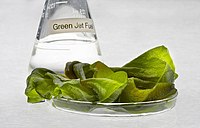
Photo from wikipedia
In this study, we estimated extracellular concentrations of algal-derived sulfur species in response to changing photoperiods. Cultures from three algal species (Chlorella vulgaris, Chlamydomonas reinhardtii, Scenedesmus obliquus) were subjected to… Click to show full abstract
In this study, we estimated extracellular concentrations of algal-derived sulfur species in response to changing photoperiods. Cultures from three algal species (Chlorella vulgaris, Chlamydomonas reinhardtii, Scenedesmus obliquus) were subjected to five different light:dark cycles (12:12, 14:10, 16:8, 18:6, 20:4 h) for a period of 3 days. Sulfur compounds including total reactive thiol concentrations, electroactive reduced sulfur species (RSS), and thiol isomers were measured using qBBr fluorescence, differential pulse cathodic stripping voltammetry (DP-CSV), and high-resolution mass spectrometry (HRMS), respectively. Total reactive thiol concentrations were greater in Scenedesmus than in Chlamydomonas and Chlorella at low light regimes (i.e., 12:12 h) whereas Chlamydomonas produced more RSS than the other two species (p < 0.05) at any light regime. Scenedesmus was the only responsive species to produce maximal electroactive RSS, and HRMS equivalent thiol compounds under low light regime, congruent with previous studies. Principal component analysis revealed relationships between qBBr-equivalent thiol and GSH-equivalent RSS concentrations for Scenedesmus and Chlamydomonas (p < 0.05) suggesting that thiols were the dominant species in the pool of electroactive RSS for these two algal species. Overall, these results showed that the light growth conditions greatly influenced the production of S-rich compounds by algae, affecting the complexation of metals such as mercury and cadmium, especially during planktonic blooms.
Journal Title: Environmental Science and Pollution Research
Year Published: 2020
Link to full text (if available)
Share on Social Media: Sign Up to like & get
recommendations!